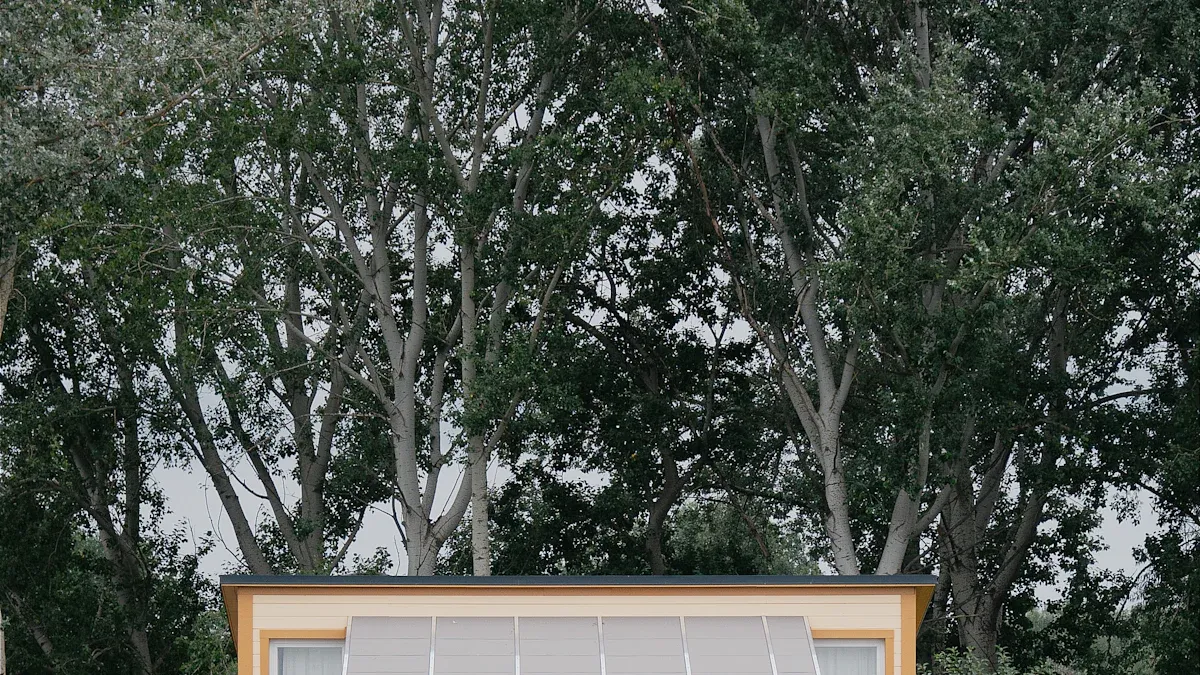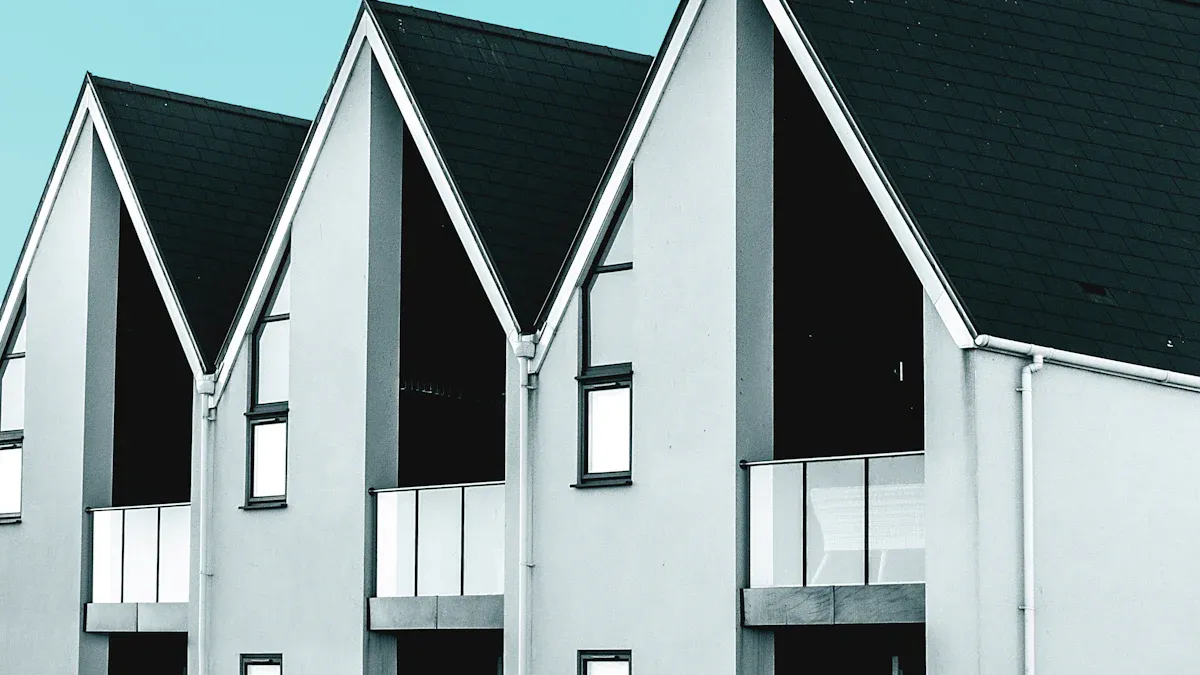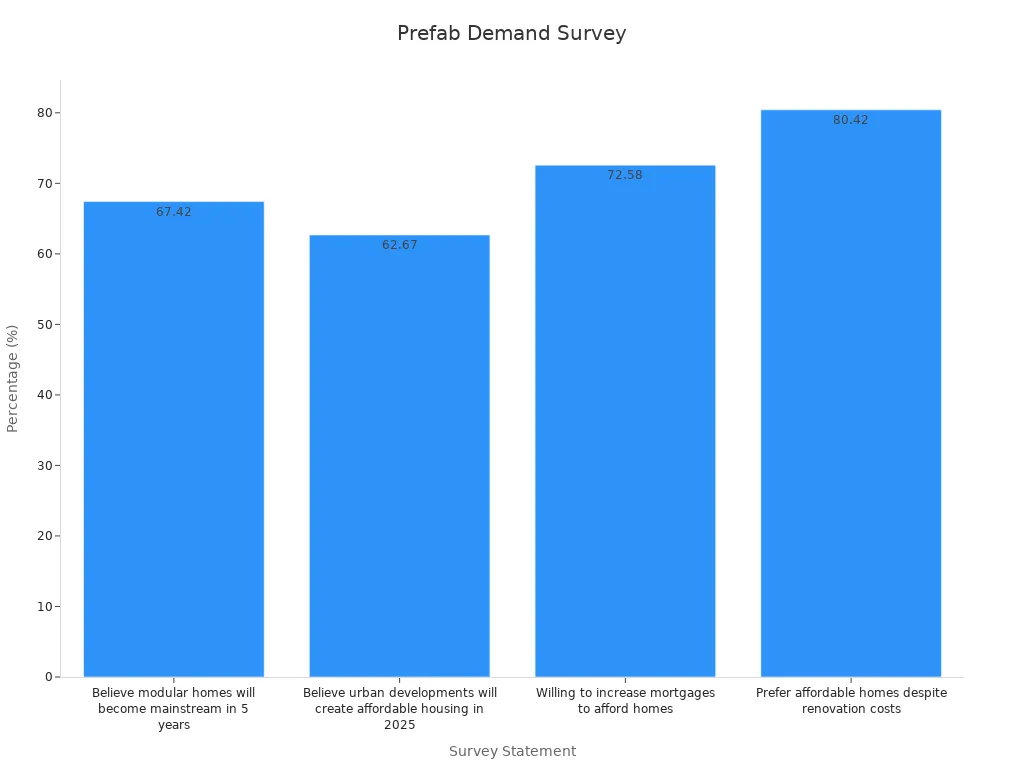
조립식 주택은 사람들이 주택을 인식하는 방식을 변화시키고 있습니다. 이 집은 환경 적으로 의식하는 동안 시간과 비용을 절약합니다. 예를 들어, 미국 조립식 주택 시장은 2024 년에서 2033 년까지 인상적인 5.8% CAGR로 성장할 것으로 예상됩니다.이 성장은 증가하는 수요를 강조합니다. 저렴한 조립식 주택효율적인 제조 공정과 인건비가 낮아짐 덕분에. 현대라고 상상해보십시오 우주 캡슐- 효율적이고 혁신적이며 오늘날의 요구를 충족시키기 위해 맞춤형.
Understanding Prefab Houses

What Are Prefab Houses?
Prefab houses, short for prefabricated houses, are homes built in sections or modules at a factory before being transported to the final site for assembly. Unlike traditional homes, which are constructed entirely on-site, prefab houses are designed for efficiency and precision. They combine modern technology with innovative construction methods to create homes that are affordable, sustainable, and customizable.
A recent survey shows that 67.42% of people believe modular homes will become mainstream within five years, highlighting the growing acceptance of prefab housing. This shift is driven by advancements in technology, lower costs, and the increasing demand for eco-friendly living spaces.
How Prefab Houses Are Built
The construction process for prefab houses begins in a controlled factory environment. Skilled workers use advanced machinery to create individual components or modules. These parts are then transported to the building site, where they are assembled like pieces of a puzzle. This method reduces construction timelines by up to 50% compared to traditional methods, ensuring faster project completion.
Factories also maintain high-quality standards, achieving a 98% defect-free rate, which minimizes rework and enhances customer satisfaction. This streamlined process not only saves time but also reduces waste, making prefab houses an environmentally friendly choice.
Types of Prefab Houses
Prefab houses come in various types, each catering to different needs and preferences. Here’s a quick overview:
| Type of Prefab Home | Key Characteristics |
|---|---|
| Mobile/Manufactured Homes | Built on a permanent chassis, regulated by HUD, can be transported, and must meet specific building codes. |
| Modular & Panelized Homes | Arrive in sections for assembly, resemble traditional homes, built to IRC standards. |
| Pod Homes | Compact design, assembled offsite, requires crane for placement, complies with IRC. |
| Kit Homes | Arrive flat-packed, require on-site assembly, user-friendly for self-construction. |
Additionally, modular units offer flexibility in design and can be combined to create larger complexes, while container homes provide a unique, industrial aesthetic. Each type has its own advantages, making prefab houses a versatile option for modern living.

Benefits of Prefab Houses
Cost Efficiency
Prefab houses are a game-changer when it comes to saving money. Their construction process is designed to optimize every step, from design to installation. By investing in the design phase, manufacturers can use materials more efficiently and reduce waste. This approach not only lowers costs but also ensures better resource utilization.
- A study highlights several cost-saving factors:
- Efficient production reduces material waste.
- Durable components minimize damage during transportation.
- Streamlined installation cuts down on labor expenses.
In Europe, the adoption of prefab technology has surged. A recent report reveals that contractors are increasingly turning to prefabrication to improve project efficiency and reduce costs. This trend underscores the financial advantages of choosing a 사전 랩 하우스 over traditional construction methods.
Time-Saving Construction
Building a prefab house is significantly faster than constructing a traditional home. The controlled factory environment allows for simultaneous production of components, which are then quickly assembled on-site. This process eliminates delays caused by weather or labor shortages.
| 건축 방법 | Onsite Time (Months) | Traditional Time (Months) |
|---|---|---|
| Prefabricated Houses | 5-8 | 18 |
The difference is striking. Prefab houses can be completed in less than half the time it takes to build a traditional home. This efficiency benefits homeowners who need a quick move-in timeline and developers looking to meet tight deadlines.
지속 가능성과 친환경
Prefab houses are not just cost-effective and fast—they’re also kind to the planet. The factory-based construction process minimizes waste and promotes the use of sustainable materials. Many prefab homes are designed with energy efficiency in mind, reducing their carbon footprint over time.
| 혜택 | 설명 |
|---|---|
| Efficient use of materials | Precise factory processes minimize waste during construction compared to traditional methods. |
| 에너지 효율적인 설계 | Many prefab homes are designed to reduce the carbon footprint over their lifetime. |
| Use of sustainable materials | Prefab manufacturers often utilize recycled or environmentally friendly materials. |
Additionally, factories can recycle unused materials, further reducing environmental impact. Homeowners also benefit from better insulation and airtight seals, which lower heating and cooling costs. Prefab houses prove that sustainability and modern living can go hand in hand.
High-Quality Manufacturing
The controlled environment of prefab factories ensures a level of quality that’s hard to achieve with traditional construction. Every stage of production is monitored to meet strict standards, resulting in fewer defects and higher customer satisfaction.
| Stage of Construction | Factors Affecting Quality Management |
|---|---|
| Early Stage | High costs, lack of equipment, unqualified personnel, poor coordination |
| Mid Construction | Inexperienced workers, low efficiency, poor communication, weather impacts |
| Later Stage | Project defects, aesthetic issues, quality defects |
By addressing these challenges in a factory setting, prefab manufacturers deliver homes that are durable, aesthetically pleasing, and built to last. Companies like Ningbo Cheerme Intelligent Furniture Co., Ltd. exemplify this commitment to quality. Since 2017, they’ve been creating modular housing solutions with a focus on high performance and user experience. Their innovative approach not only saves costs but also supports global efforts toward carbon neutrality.
The Future of Prefab Houses
Technological Innovations
The prefab housing industry is embracing cutting-edge technologies to redefine how homes are built and lived in. These innovations are making construction faster, safer, and more efficient. For example, tools like the Real-Time Evaluator provide instant feedback to installers, ensuring precise placement of prefabricated panels. This not only speeds up the process but also reduces errors. Similarly, the Autonomous Spray Foam Installer enhances insulation quality while minimizing waste and installation costs.
Another exciting development is the On-Demand, Pressure-Triggered Sealant, which was a finalist for the 2023 R&D 100 Awards. This technology simplifies construction by improving sealing efficiency, making prefab houses even more durable and energy-efficient.
| Innovation | 설명 |
|---|---|
| Real-Time Evaluator Tool | Provides instant feedback for precise panel placement during construction. |
| Autonomous Spray Foam Installer | Improves insulation quality, reduces waste, and lowers costs. |
| On-Demand, Pressure-Triggered Sealant | Enhances sealing efficiency, ensuring durability and energy savings. |
Beyond construction, smart home technology is becoming a staple in prefab houses. Features like automated lighting, energy monitoring, and security systems offer convenience and sustainability. These advancements cater to tech-savvy homeowners while aligning with the growing demand for eco-friendly living spaces.
Addressing Housing Shortages
Prefab houses are emerging as a practical solution to the global housing crisis. Urbanization has increased the demand for affordable homes, and traditional construction methods often fail to keep up. Prefab houses, with their quick assembly and cost-effective production, are bridging this gap. Governments are also stepping in with incentives to promote affordable housing initiatives, further boosting the adoption of prefab homes.
The numbers tell a compelling story. In 2023, affordable home listings dropped from 21% to 16%, highlighting the urgent need for alternative housing solutions. Prefab houses address this issue by reducing construction costs and labor requirements. Their modular design allows for rapid production, making them ideal for areas with high housing demand.
- Key factors driving the adoption of prefab houses:
- Urbanization and rising housing demand.
- Cost-effective construction methods.
- Government incentives for affordable housing.
- Decline in affordable home listings, emphasizing the need for innovative solutions.
By offering a faster and more affordable way to build homes, prefab houses are playing a crucial role in tackling housing shortages worldwide.
Market Growth and Trends
The prefab housing market is on a steady growth trajectory, with North America leading the charge. Over the next five years, this region is expected to remain the largest market for prefab houses, driven by increasing demand for sustainable and affordable housing. It is also projected to witness the highest growth rate during this period.
Globally, the market is set to grow from USD 143.55 billion in 2025 to USD 198.24 billion by 2030, with a compound annual growth rate (CAGR) of 6.67%. Single-family prefab homes are expected to dominate this growth, reflecting their popularity among homeowners seeking cost-effective and customizable housing options.
| Segment Type | Market Size (2025) | Market Size (2030) | CAGR (%) |
|---|---|---|---|
| Single-family | USD 143.55 billion | USD 198.24 billion | 6.67 |
| Multi-family | N/A | N/A | N/A |
This growth is fueled by advancements in technology, increased awareness of sustainable living, and the rising need for affordable housing. As prefab houses continue to evolve, they are poised to become a cornerstone of the global housing market.
Prefab homes are reshaping the housing industry with their innovative approach. They offer:
- Affordability: Modular construction cuts costs and timelines, making homes more accessible.
- 능률: 빠른 조립은 긴급한 주택 요구를 충족시킵니다.
- 지속 가능성: The와 같은 프로젝트 J57 미니 시티 스카이 스크래퍼 자원 사용을 줄이고 증명합니다 친환경.
Ningbo Cheerme Intelligent Furniture Co., Ltd.와 같은 회사는 이러한 변화를 이끌어 비용을 절약하고 탄소 중립을 지원하는 모듈 식 솔루션을 만듭니다.
FAQ
Prefab 주택이 전통적인 주택과 다른 이유는 무엇입니까?
Prefab 주택은 공장에 지어져 있으며 현장에서 조립됩니다. 이 과정은 건설 시간을 줄이고 폐기물을 최소화하며 전통적인 가정에 비해 일관된 품질을 보장합니다.
Prefab 주택은 사용자 정의 할 수 있습니까?
예! 조립식 주택 제공 다양한 디자인 옵션. 구매자는 레이아웃, 마감 및 기능을 선택하여 스타일과 요구에 맞는 집을 만들 수 있습니다.
팁: Ningbo Cheerme Intelligent Furniture Co., Ltd.와 같은 회사는 모듈 식 디자인, 유연성과 고성능을 제공합니다.
프리브 랩 집을 짓는 데 얼마나 걸립니까?
조립식 주택은 일반적으로 완료하는 데 5-8 개월이 걸립니다. 여기에는 공장 생산 및 현장 어셈블리가 포함되며, 이는 전통적인 건축 타임 라인보다 훨씬 빠릅니다.

